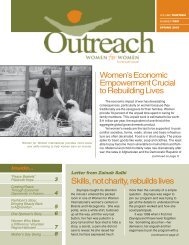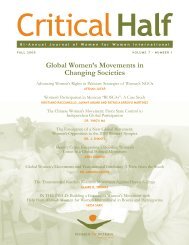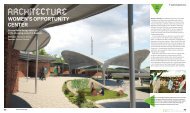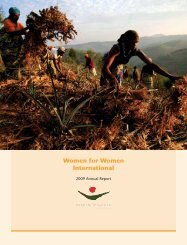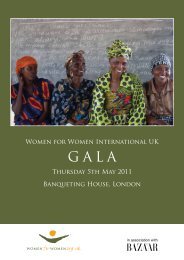Gender and Constitution Building - Women for Women International
Gender and Constitution Building - Women for Women International
Gender and Constitution Building - Women for Women International
Create successful ePaper yourself
Turn your PDF publications into a flip-book with our unique Google optimized e-Paper software.
women opted instead <strong>for</strong> a National <strong>Gender</strong> Machinery<br />
Framework, which created three different sites of advocacy<br />
<strong>and</strong> negotiation in mainstreaming gender equality<br />
in the country. The structures include:<br />
(1) The Office on the Status of <strong>Women</strong> (OSW)-an<br />
administrative body that serves as an internal<br />
monitoring <strong>and</strong> accountability structure to hold<br />
the government accountable to their gender<br />
equality commitments. 9<br />
(2) The Joint Monitoring Committee on the<br />
Quality of Life <strong>and</strong> Status of <strong>Women</strong> (JMC)-a<br />
facilitating <strong>for</strong>um <strong>for</strong> public input into legislative<br />
processes, which also acts as an internal accountability<br />
mechanism within Parliament to monitor<br />
legislation, debates in Parliament etc., to ensure<br />
compliance with both constitutional <strong>and</strong> international<br />
obligations in respect to gender equality<br />
<strong>and</strong> women’s human rights.<br />
(3) The Commission <strong>for</strong> <strong>Gender</strong> Equality (CGE)a<br />
constitutionally-created, independent body<br />
established in 1996 as one of the six state institutions<br />
set up to strengthen constitutional democracy.<br />
The broad role of the CGE includes the<br />
promotion of respect <strong>for</strong> gender equality <strong>and</strong> the<br />
protection, development <strong>and</strong> attainment of<br />
gender equality. 10 The <strong>Constitution</strong> provides that<br />
the CGE must promote respect <strong>for</strong> the protection,<br />
development <strong>and</strong> attainment of gender<br />
equality. It also has the power to monitor, investigate,<br />
research, educate, lobby, advise <strong>and</strong> report<br />
on issues concerning gender equality. 11 The<br />
Commission is accountable to the National<br />
Assembly in Parliament. It must report on its<br />
activities <strong>and</strong> the per<strong>for</strong>mance of its functions to<br />
the National Assembly at least once a year.<br />
The Truth <strong>and</strong> Reconciliation Commission<br />
One of the challenges of drafting the new <strong>Constitution</strong><br />
was incorporating a mechanism that could remedy<br />
some of the human rights abuses that occurred under<br />
apartheid in a way that would facilitate peaceful coexistence<br />
of previously polarized groups. Creation of a<br />
judicial process similar to the Nuremberg trials was discussed<br />
<strong>and</strong> rejected, as was the possibility of a system<br />
of blanket amnesties. The third proposal was a truth<br />
<strong>and</strong> reconciliation process, which aimed <strong>for</strong> a model of<br />
restorative justice, as opposed to a retributive/punitive<br />
model of justice.<br />
The truth <strong>and</strong> reconciliation concept was accepted<br />
<strong>and</strong> written into the post-amble to the 1993 Interim<br />
<strong>Constitution</strong> in language that m<strong>and</strong>ated the establishment<br />
of a body called the Truth <strong>and</strong> Reconciliation<br />
Commission (TRC). The Promotion of National Unity<br />
<strong>and</strong> Reconciliation Act 34 of 1995 is the enabling legislation<br />
<strong>for</strong> the Truth <strong>and</strong> Reconciliation Commission.<br />
It is a quasi-judicial body that reflects the diversity of<br />
the country across racial lines, religious systems <strong>and</strong> a<br />
range of political affiliations. The TRC’s principle objectives<br />
are to investigate <strong>and</strong> document human rights<br />
violations, make proposals <strong>for</strong> measures that will give<br />
reparation to victims of human rights violations, grant<br />
conditional amnesty <strong>and</strong> rehabilitate <strong>and</strong> give back the<br />
human <strong>and</strong> civil dignity of people who suffered human<br />
rights violations. 12<br />
“Reparation” <strong>and</strong> “rehabilitation” are words to describe<br />
what can be done to help victims overcome the<br />
damage that they suffered, to give them back their dignity<br />
<strong>and</strong> to make sure that these abuses do not happen<br />
again. In fact, “[e]ntitlement to reparation…arises from<br />
the provision of the Act itself. The only qualification<br />
is that the recipient must be a victim of a gross violation<br />
of human rights as defined in…the Act.” 13<br />
The TRC Act is gender-blind, with no specific reference<br />
to women, gender or to gender-based violence.<br />
In March 1996, when the TRC began its work, gender<br />
activists were concerned about a potential gender bias<br />
in the TRC process. Concerns were raised that statistically,<br />
although half of the testifiers were women, the<br />
majority of the women testifying spoke of violence<br />
pertaining to relatives <strong>and</strong> dependants (primarily males)<br />
who had suffered human rights violations. In other<br />
words, women spoke as secondary victims, thus making<br />
them ineligible <strong>for</strong> reparations. Men, on the other<br />
h<strong>and</strong>, spoke of their experiences as direct victims. A<br />
large number of women also spoke of severe ill treatment,<br />
but not of the torture that a number of them<br />
had experienced. 14<br />
In response to this situation, the TRC agreed to<br />
hold special women’s hearings <strong>and</strong> made some procedural<br />
changes to encourage women to come <strong>for</strong>ward<br />
<strong>and</strong> speak about their own experiences as victims, as<br />
opposed to only testifying about acts relating to family<br />
members or friends.<br />
Conclusion<br />
South Africa’s <strong>Constitution</strong> bears testimony to a<br />
long struggle <strong>for</strong> justice <strong>and</strong> equality by South African<br />
women by explicitly recognizing the injustices of the<br />
past <strong>and</strong> honoring those who suffered <strong>for</strong> freedom <strong>and</strong><br />
justice. However, with so much focus on the racial implications<br />
of apartheid, the gender inequities that were<br />
CRITICAL HALF 43



